PR
X
Keyword Search
▼キーワード検索
Comments
続日本100名城東北の…
New!
オジン0523さん
【甥のステント挿入… New!
Gママさん
New!
Gママさん
2025年版・岡山大学… New!
隠居人はせじぃさん
New!
隠居人はせじぃさん
ムベの実を開くコツ… noahnoahnoahさん
noahnoahnoahさん
エコハウスにようこそ ecologicianさん
【甥のステント挿入…
 New!
Gママさん
New!
Gママさん2025年版・岡山大学…
 New!
隠居人はせじぃさん
New!
隠居人はせじぃさんムベの実を開くコツ…
 noahnoahnoahさん
noahnoahnoahさんエコハウスにようこそ ecologicianさん
Calendar
カテゴリ: 海外旅行
ディングル半島北部・大西洋側に位置する絶壁の近くから、絶景をひたすら楽しむ。
何故かといえば、 我が人生でこの目で大西洋を地上から直接見るのは これが最後であると
感じていたのであった。
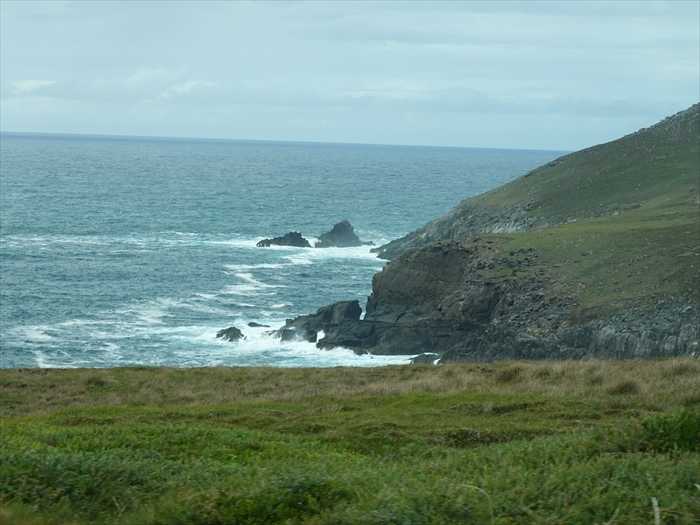
Ballydavid Head(ベリーデイヴィッド岬)付近の無名??の岩峰 を見る。
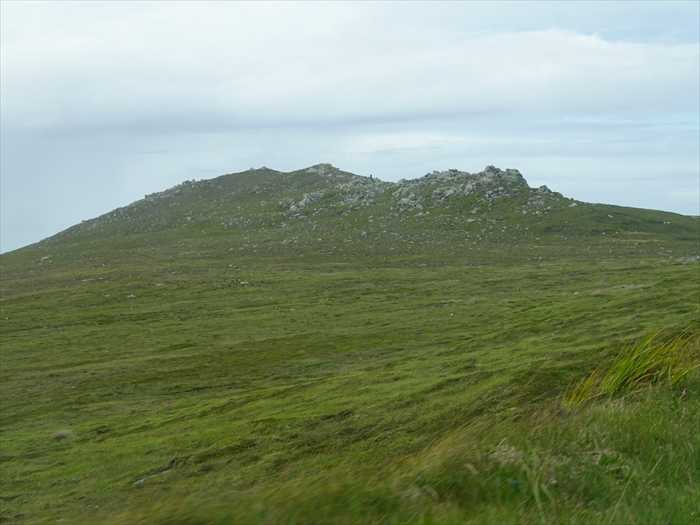
Ballydavid Head(ベリーデイヴィッド岬) 。
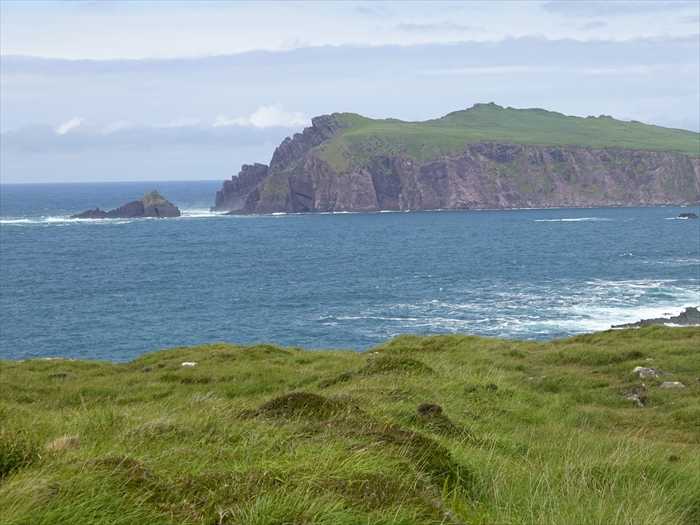
Ballydavid Head(ベリーデイヴィッド岬)の付け根方向。
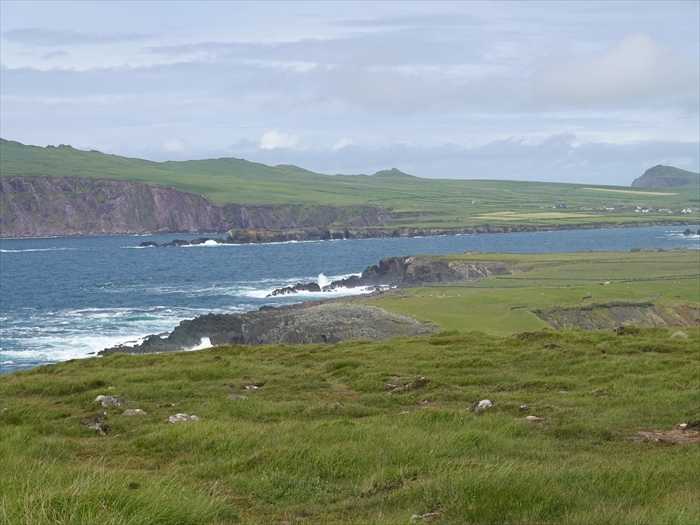
青と白、緑の絶景のカオスをカメラで追う。
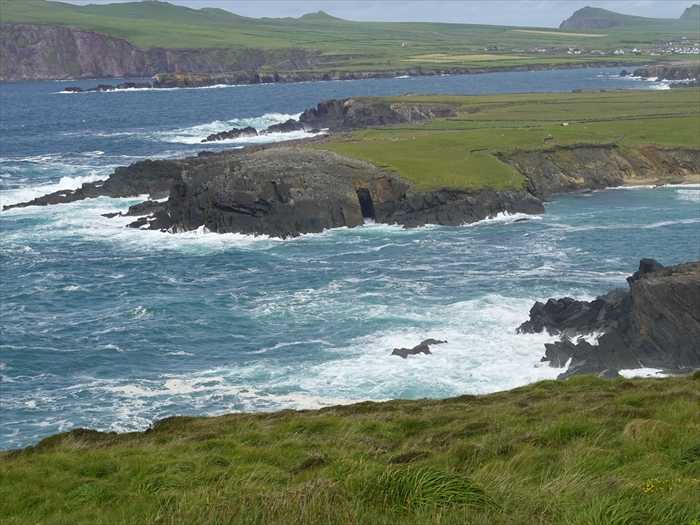
白い波頭が岩礁に砕け散るたび、刻一刻と海の姿が変わるのであった。
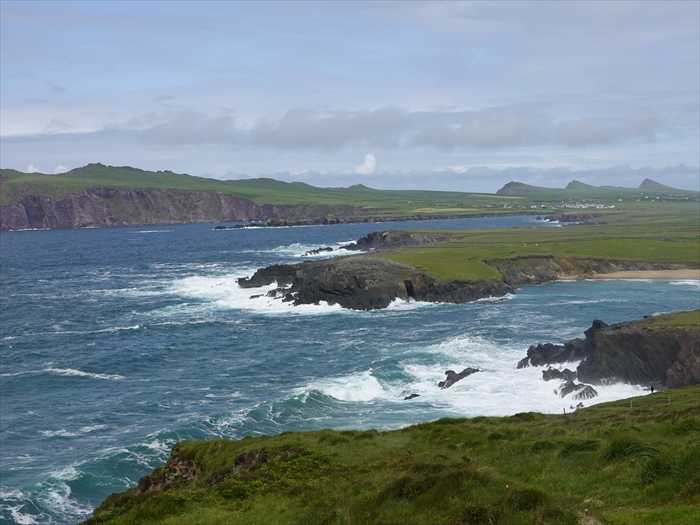
ズームして。
刻々と移ろうのであった。
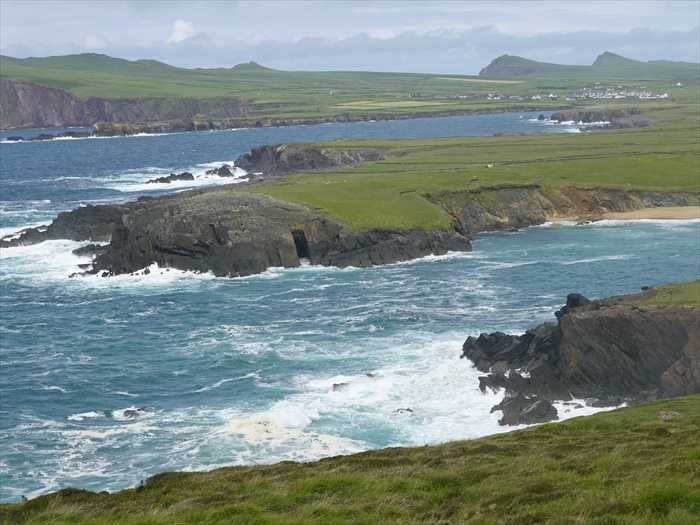
吹きすさぶ潮風と荒々しい波が、切り立つ崖を絶え間なく打ち続ける。
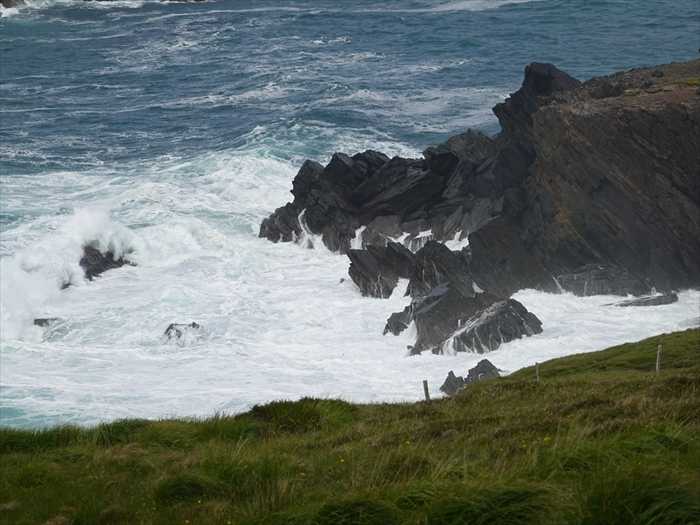
一方で、打ち寄せた波が静かに引く瞬間、海面は絹のような柔らかさを帯びる。

緑の草地と黒褐色の岩肌、そこに白い波が絡みつき、色と質感の対比が視覚的な調和を。
波が岩壁にぶつかるたびに生まれる泡のしぶきは、まるで海の息吹そのもの。
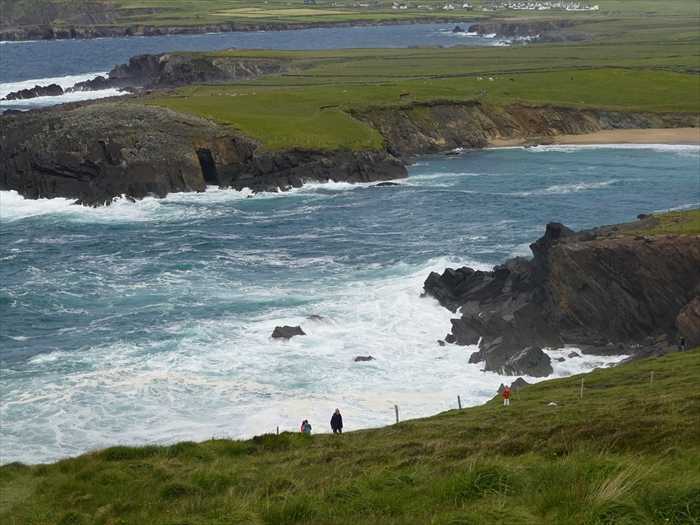
激しく跳ねる水飛沫が、逆光に照らされて宝石のように輝くのであった。
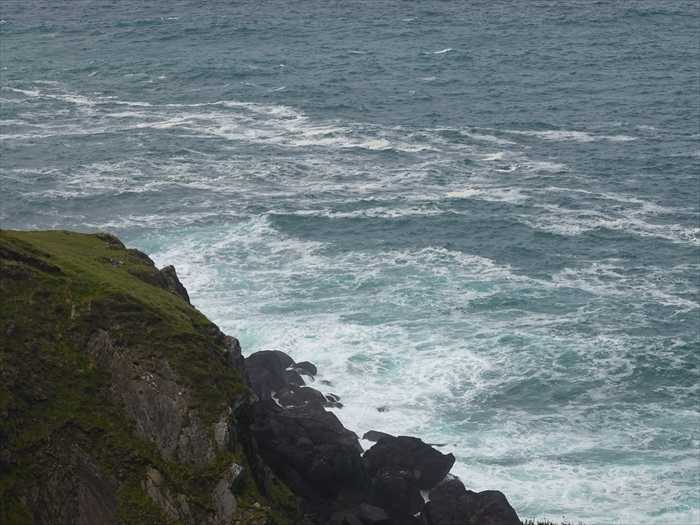
崖の縁に立つと、眼下に広がる海は果てしなく、どこか異世界のような静謐さを感じさせる
のであった。
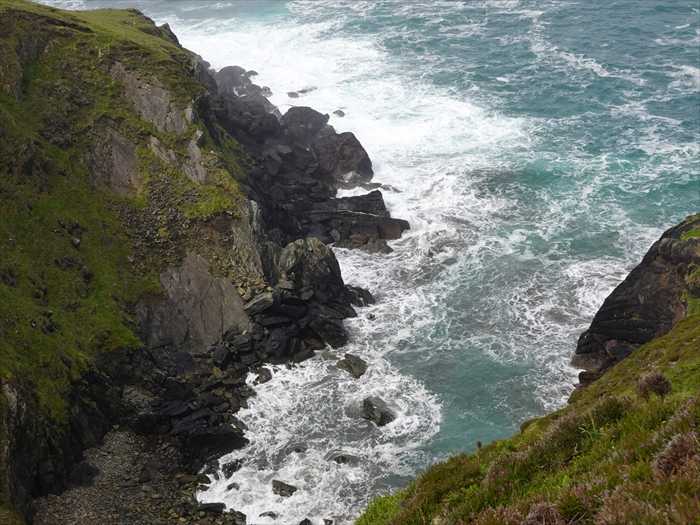
ズームして。
人の気配のない絶壁の風景は、太古の自然そのものを思わせるのであった。
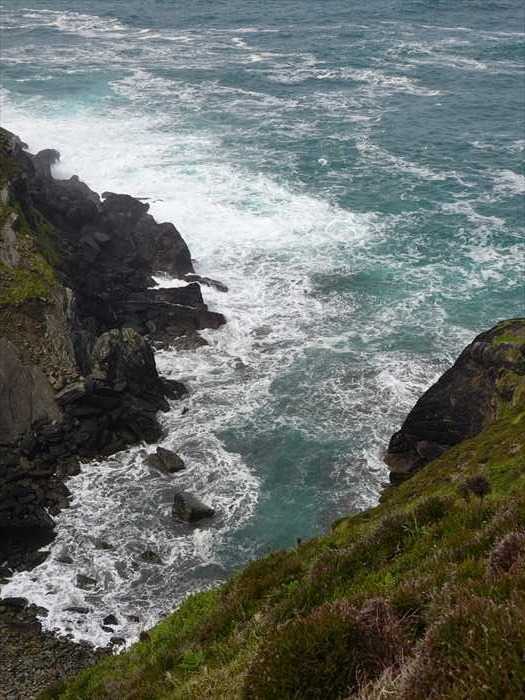
右奥の 三角形状の3つの山 アイルランド・ケリー州のディングル半島北岸にある
Three Sisters(三姉妹) と呼ばれる特徴的な連峰。
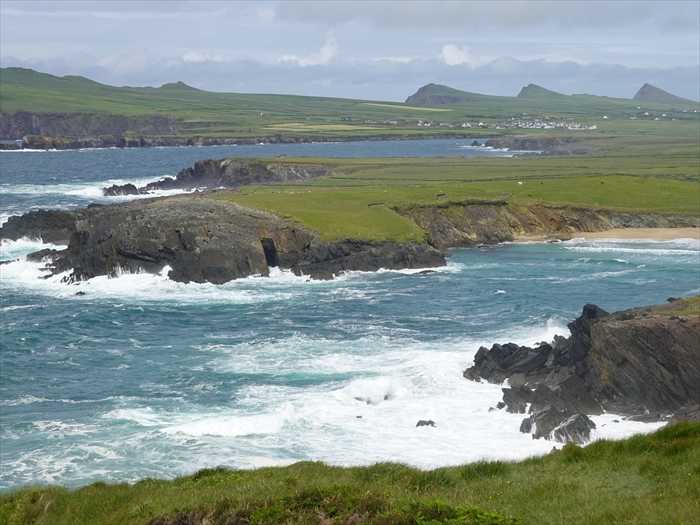
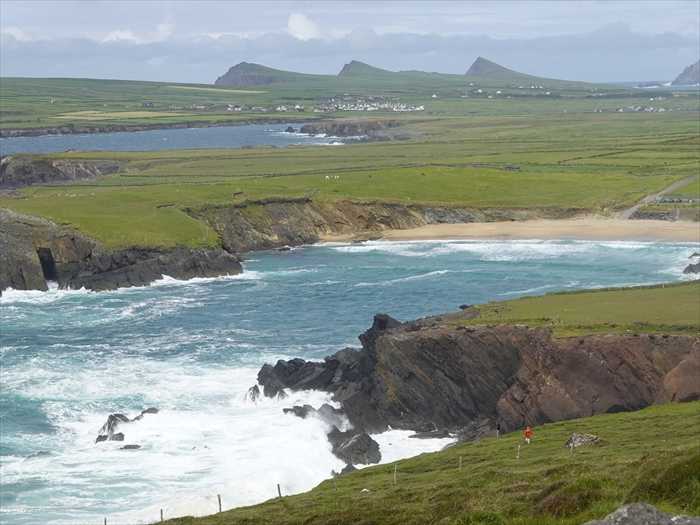
この四角い穴は自然の産物であろうか?
自然の浸食作用によって形成された 海食洞(sea cave) !?
ディングル半島は、頁岩(シェール)や砂岩、堆積岩などの層状の堅い地質を持つため、
風化と波の作用によって垂直や直線的な割れ目が生じやすい地形である と。

Ceann Sraithe(ケアン・スラーまたは
ストラヘ・ヘッド) に設置された看板。
Ceann Sraithe は ゲール語で「草地の岬(Headland of the Strand) 」を意味し、
アイルランド語圏のケリー県の西端に位置。
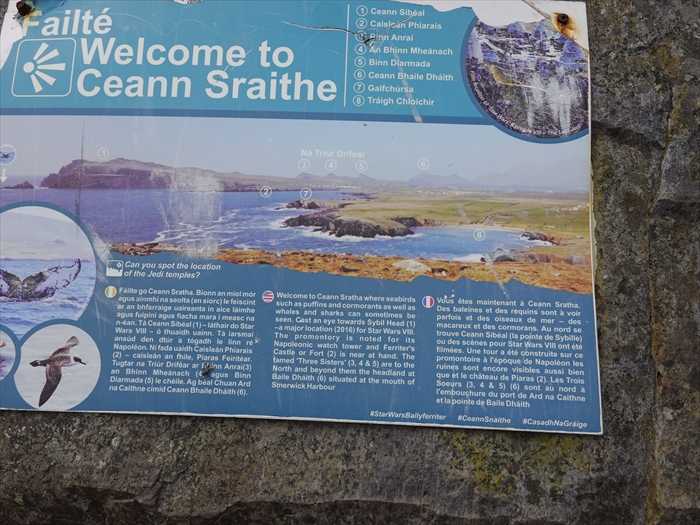
「 Welcome to Ceann Sraithe
Welcome to Ceann Sratha where seabirds such as puffins and cormorants as well as
whales and sharks can sometimes be seen.
Cast an eye towards Sybil Head (1) – a major location (2016) for Star Wars VIII.
The promontory is noted for its Napoleonic watch tower and Ferriter's Castle or
Fort (2) is near at hand.
The famed 'Three Sisters' (3, 4 & 5) are to the North and beyond them the headland
at Baile Dháith (6) situated at the mouth of Smerwick Harbour.」
【 ケアン・スラーへようこそ。
ここでは、パフィン(ニシツノメドリ)や鵜(ウ)などの海鳥のほか、クジラやサメが見られる
こともあります。
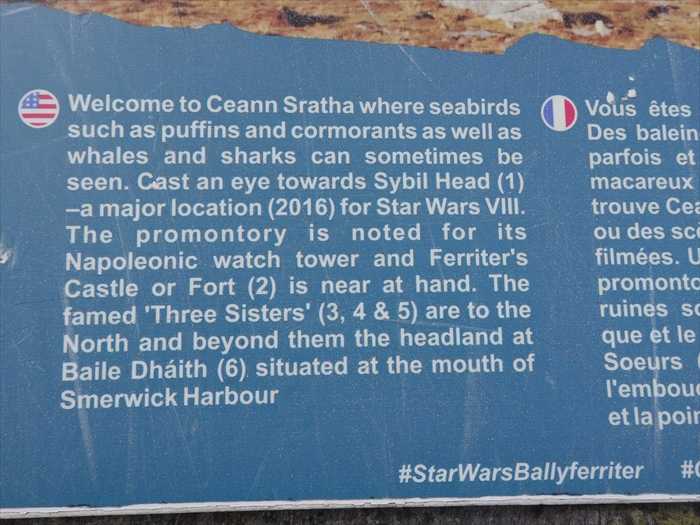
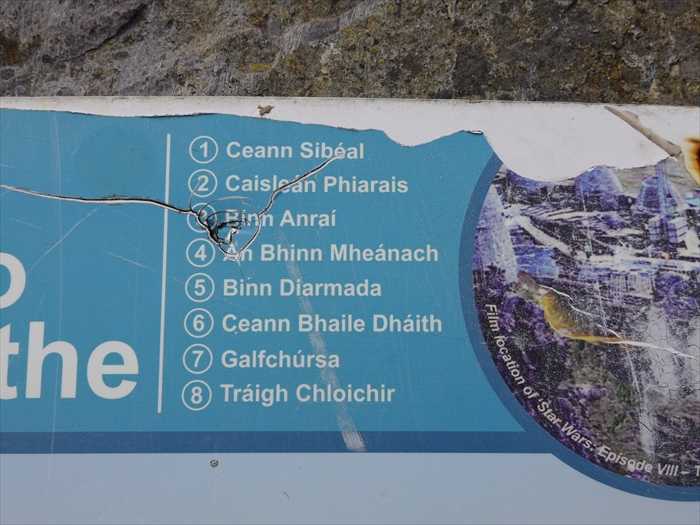
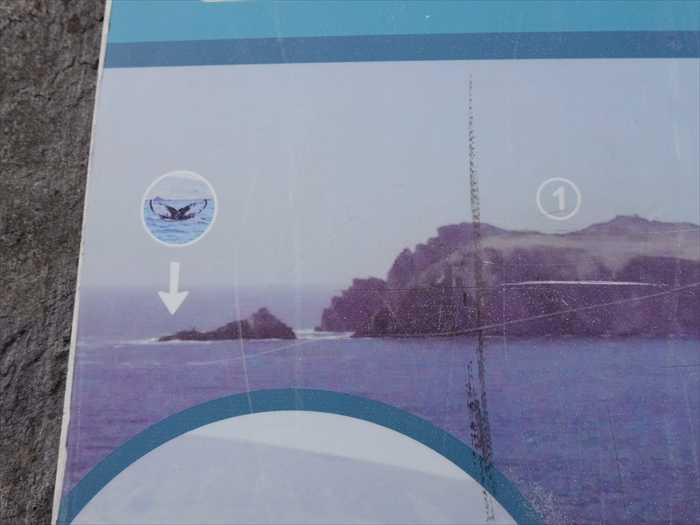
この岩は、 ザトウクジラ(Humpback Whale)の尾びれ(fluke)を
想起させる形である!? と。
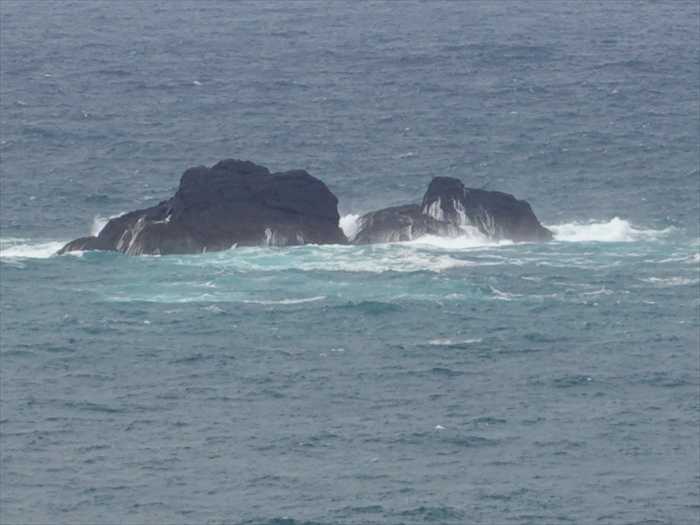
ザトウクジラ(Humpback Whale)の尾びれ(フルーク)。
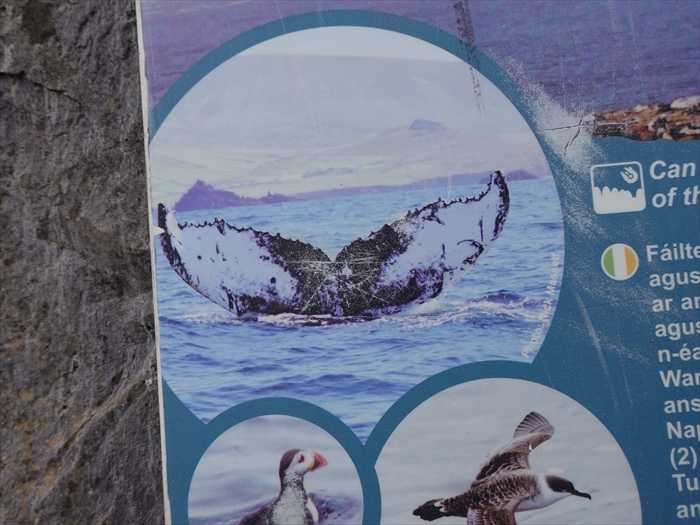
Ceann Sraithe(草地の岬)を後にしてR559を進む。
「 放牧中の羊たち 」の姿を車窓から。
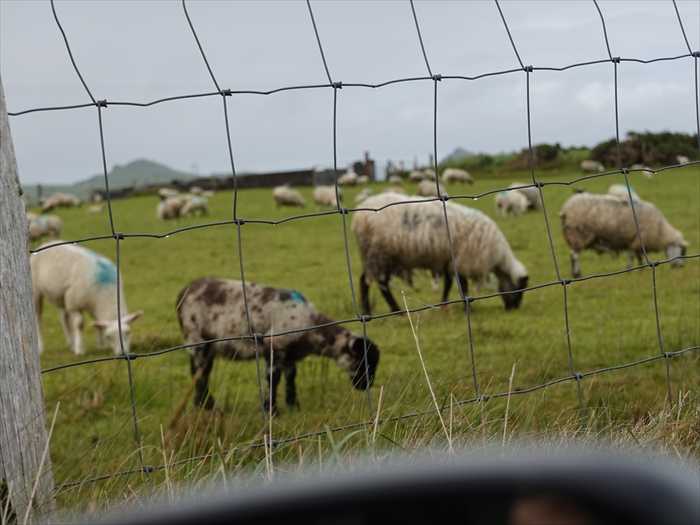
ピントが金網に邪魔されて。

3つ星ホテル・Ceann Sibéal Hotel。
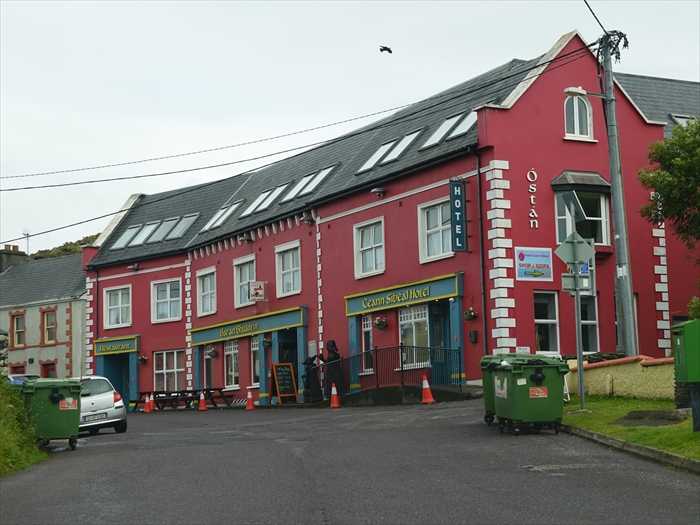
その先、右側には「 カトリック教会・Séipéal Uinsinn Naofa
(St. Vincent's Church / 聖ヴィンセント教会) 」。

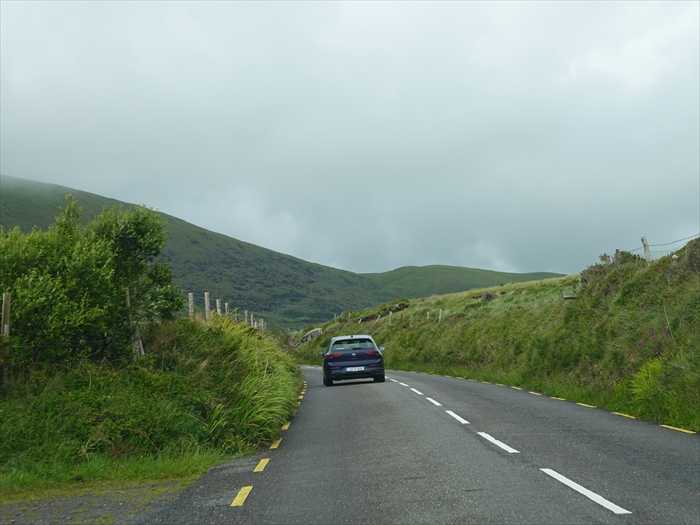
さらにR559の山道を上って行った。

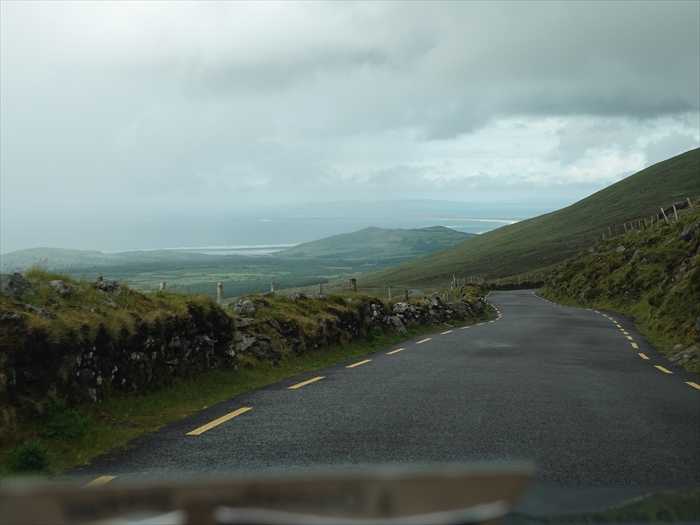
R560の右側にあったパネル。
ケリー県西部(West Kerry)における 氷河時代の地形と地質を解説するパネル 。
「 The Ice Age at Pedler’s Lake
【ペドラーズ湖の氷河時代
「In 1837 the Swiss geologist Louis Agassiz said for the first
【1837年、スイスの地質学者ルイ・アガシーが初めて、
「During the Ordovician and Silurian Ireland was south of the equator; and under
an ocean between two continents. Mud and sand deposited into it eventually became
the rocks seen near Annascaul. In the Silurian, volcanic islands erupted lavas and ash,
now found at Clogher Head. Muddy sediments trapped animals preserved as fossils
near Dún Chaoin and on Caherconree Mountain. Younger sandy sediments produced
the sandstones near An Daingean and Slea Head.
depressions called corries many of which now contain lakes. Glaciers moved downslope
along river valleys, and when they melted boulder clay containing many different
rock types was deposited.」
【オルドビス紀およびシルル紀の間、アイルランドは赤道の南に位置し、2つの大陸の間の
海の下にありました。
(ボルダー・クレイ)を残しました。】
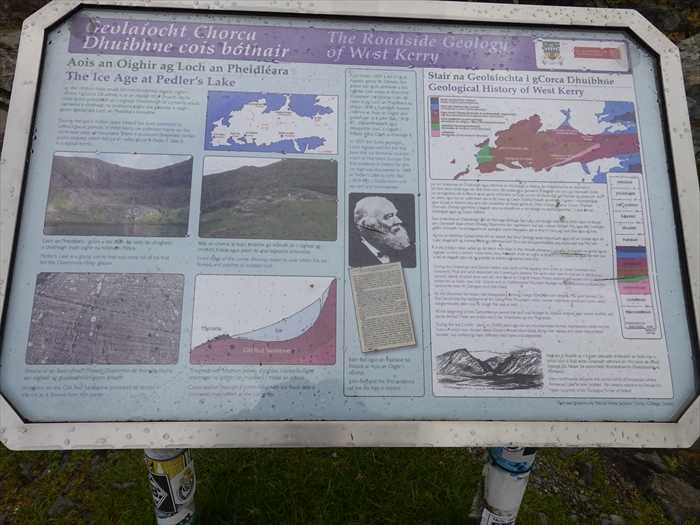
右手に 小さな滝 が流れていた。

近づいて。

「Old Red Sandstone」(古赤色砂岩)で、これは氷河による擦痕(グレージング striations)で、
氷河が通過した際に岩の破片で削られた痕跡であると。
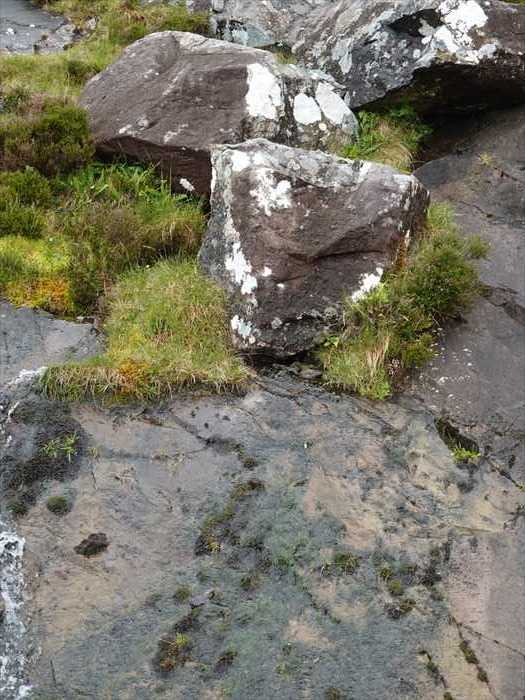
眼下左にはいくつかの沼の姿が。
Pedler’s Lake(Loch an Pheidléara)周辺の氷河地形 を。

Connor Pass(コナー峠)近くにあるPedler’s Lake(ペドラーズ湖)付近の断崖地形。

移動して小滝を。
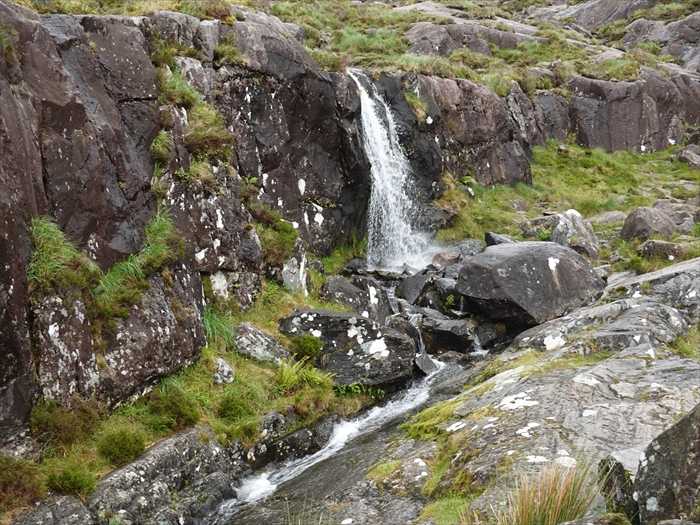
正面に Brandon Bay(ブランドン湾) 。

リー川に架かる「 Blennerville Bridge 」を渡る。

N70をひたすら進む。

真っ赤な路線バスが前方を。
バス名:Expresswayは アイルランド国営の長距離高速バスブランド)バス と。

・・・ もどる ・・・
・・・ つづく ・・・
何故かといえば、 我が人生でこの目で大西洋を地上から直接見るのは これが最後であると
感じていたのであった。

Ballydavid Head(ベリーデイヴィッド岬)付近の無名??の岩峰 を見る。
標高はおおよそ300〜400メートル?。
・岩がむき出しの丘陵状の山容。
・植生は低い草地中心で、山頂部は岩だらけ。
・海岸線からすぐ近く、断崖地帯に連なる一部 であったが。

Ballydavid Head(ベリーデイヴィッド岬) 。

Ballydavid Head(ベリーデイヴィッド岬)の付け根方向。

青と白、緑の絶景のカオスをカメラで追う。

白い波頭が岩礁に砕け散るたび、刻一刻と海の姿が変わるのであった。

ズームして。
刻々と移ろうのであった。

吹きすさぶ潮風と荒々しい波が、切り立つ崖を絶え間なく打ち続ける。

一方で、打ち寄せた波が静かに引く瞬間、海面は絹のような柔らかさを帯びる。

緑の草地と黒褐色の岩肌、そこに白い波が絡みつき、色と質感の対比が視覚的な調和を。
波が岩壁にぶつかるたびに生まれる泡のしぶきは、まるで海の息吹そのもの。

激しく跳ねる水飛沫が、逆光に照らされて宝石のように輝くのであった。

崖の縁に立つと、眼下に広がる海は果てしなく、どこか異世界のような静謐さを感じさせる
のであった。

ズームして。
人の気配のない絶壁の風景は、太古の自然そのものを思わせるのであった。

右奥の 三角形状の3つの山 アイルランド・ケリー州のディングル半島北岸にある
Three Sisters(三姉妹) と呼ばれる特徴的な連峰。

各山の名前(東から西へ)
通称
アイルランド語名(英語表記)
説明
① Binn Diarmada(ビン・ディアマダ)Diarmuid’s Peak最も東側。三姉妹の中で最も緩やかな山
② Binn Hanrai(ビン・ハンライ) Henry’s Peak真ん中のピーク
③ Binn Meanach(ビン・マーナフ)Middle Peak(最も西で鋭角な山。最も目立つ三角形)
前景の海岸は Clogher Strand または Clogher Beach(クロガー・ストランド) 。
前景の海岸は Clogher Strand または Clogher Beach(クロガー・ストランド) 。

この四角い穴は自然の産物であろうか?
自然の浸食作用によって形成された 海食洞(sea cave) !?
ディングル半島は、頁岩(シェール)や砂岩、堆積岩などの層状の堅い地質を持つため、
風化と波の作用によって垂直や直線的な割れ目が生じやすい地形である と。

Ceann Sraithe(ケアン・スラーまたは
ストラヘ・ヘッド) に設置された看板。
Ceann Sraithe は ゲール語で「草地の岬(Headland of the Strand) 」を意味し、
アイルランド語圏のケリー県の西端に位置。

「 Welcome to Ceann Sraithe
Welcome to Ceann Sratha where seabirds such as puffins and cormorants as well as
whales and sharks can sometimes be seen.
Cast an eye towards Sybil Head (1) – a major location (2016) for Star Wars VIII.
The promontory is noted for its Napoleonic watch tower and Ferriter's Castle or
Fort (2) is near at hand.
The famed 'Three Sisters' (3, 4 & 5) are to the North and beyond them the headland
at Baile Dháith (6) situated at the mouth of Smerwick Harbour.」
【 ケアン・スラーへようこそ。
ここでは、パフィン(ニシツノメドリ)や鵜(ウ)などの海鳥のほか、クジラやサメが見られる
こともあります。
シビル・ヘッド(Sybil Head)(①)
『スター・ウォーズ エピソード8/最後のジェダイ』の主要なロケ地の一つとなりました。
『スター・ウォーズ エピソード8/最後のジェダイ』の主要なロケ地の一つとなりました。
この岬は、ナポレオン時代の見張り塔で知られており、近くには フェリター城(または砦)
(②) もあります。
(②) もあります。
有名な 「スリー・シスターズ(三姉妹)」の丘々(③、④、⑤)
は北に位置し、それを越えると、
スマーウィック湾の入口にある ベール・ダーフ(Baile Dháith)(⑥) の岬が見えてきます。】
スマーウィック湾の入口にある ベール・ダーフ(Baile Dháith)(⑥) の岬が見えてきます。】

①Ceann Sibéal(ケアン・シビール)
→ 有名な映画『スター・ウォーズ』の撮影地
②Cathair na gPiaras(キャハー・ナ・ピアラス)
→ 古代の石の要塞跡、ピアス氏族の居城跡とされる
③An Áird
→ 岬の突端部分(Headland)
④An Bhinn Mhéanach(アン・ヴィン・ヴェーニャハ)
→ 「中間の峰」の意味の丘
⑤Binn Dáimeas
→ 「敬意の丘」と訳されることもある地形
⑥Ceann Bhéal Dúin
→ 「砦の口の岬」の意味(古代の防衛施設があったとされる)
⑦Gallarus(ガラルス)
→ 有名な「Gallarus Oratory(ガラルス礼拝堂)」がある地域
⑧Tráigh Chloichí
→ 小石の浜辺


この岩は、 ザトウクジラ(Humpback Whale)の尾びれ(fluke)を
想起させる形である!? と。

ザトウクジラ(Humpback Whale)の尾びれ(フルーク)。
この地域(スマーウィック湾周辺)では、運が良ければクジラが見られるということを
視覚的に示しているだと。
視覚的に示しているだと。
特に写っているのは、クジラが潜る直前に尾びれを海上に持ち上げる瞬間であり、これは
ホエールウォッチングでよく知られるシーン と。
左右に広がったシルエットが、海面から尾びれを持ち上げた瞬間の姿に似ている と。
ホエールウォッチングでよく知られるシーン と。
左右に広がったシルエットが、海面から尾びれを持ち上げた瞬間の姿に似ている と。

Ceann Sraithe(草地の岬)を後にしてR559を進む。
「 放牧中の羊たち 」の姿を車窓から。

ピントが金網に邪魔されて。

3つ星ホテル・Ceann Sibéal Hotel。

その先、右側には「 カトリック教会・Séipéal Uinsinn Naofa
(St. Vincent's Church / 聖ヴィンセント教会) 」。


さらにR559の山道を上って行った。


R560の右側にあったパネル。
ケリー県西部(West Kerry)における 氷河時代の地形と地質を解説するパネル 。
「 The Ice Age at Pedler’s Lake
During the last 2 million years Ireland has been subjected to various glacial periods.
In West Kerry, ice collected mainly on the north-east side of mountains.
There it produced deepened corries (cwm, cirques) which fed ice to valley glaciers.
Pedler’s Lake is in a typical corrie.」 【ペドラーズ湖の氷河時代
約2万5千年前の最終氷期の頃、アイルランドのほぼ全域はスコットランドから南下した巨大な
氷床に覆われていました。氷河は谷を下りながら地形を削り、深めていきました。
ペドラーズ湖は、山の北側にある氷河のすり鉢状の窪地(カリー)に氷河が削って形成された
ものです。急な後壁と平らな湖底を持つ、氷河地形の好例として残っています。
氷床に覆われていました。氷河は谷を下りながら地形を削り、深めていきました。
ペドラーズ湖は、山の北側にある氷河のすり鉢状の窪地(カリー)に氷河が削って形成された
ものです。急な後壁と平らな湖底を持つ、氷河地形の好例として残っています。
「In 1837 the Swiss geologist Louis Agassiz said for the first
time, that ice formerly covered much of Northern Europe. The
first evidence in Ireland for the ice Age was discovered in 1848
at Pedler’s Lake by John Ball (1818–89), a Dublin-born civil
servant and mountaineer.」 【1837年、スイスの地質学者ルイ・アガシーが初めて、
かつて氷が北ヨーロッパの大部分を覆っていたと述べました。
アイルランドにおける氷河時代の最初の証拠は、1848年に
ペドラーズ湖でジョン・ボール(1818–1889)によって発見されました。
彼はダブリン生まれの官僚であり登山家でもありました。】「During the Ordovician and Silurian Ireland was south of the equator; and under
an ocean between two continents. Mud and sand deposited into it eventually became
the rocks seen near Annascaul. In the Silurian, volcanic islands erupted lavas and ash,
now found at Clogher Head. Muddy sediments trapped animals preserved as fossils
near Dún Chaoin and on Caherconree Mountain. Younger sandy sediments produced
the sandstones near An Daingean and Slea Head.
By the Devonian, the ocean had disappeared, forming a large continent with deserts.
The sand formed Old Red Sandstone, the backbone of the Slieve Mish Mountains,
while coarser sediments produced rocks called conglomerates, seen now at Lough Slat
and at Inch.
The sand formed Old Red Sandstone, the backbone of the Slieve Mish Mountains,
while coarser sediments produced rocks called conglomerates, seen now at Lough Slat
and at Inch.
At the beginning of the Carboniferous period the land was flooded by shallow tropical
seas where shellfish and corals thrived. These are preserved in the limestones
on the Magharees.
During the last 2 million years to 10,000 years ago, ice on mountainsides formedseas where shellfish and corals thrived. These are preserved in the limestones
on the Magharees.
depressions called corries many of which now contain lakes. Glaciers moved downslope
along river valleys, and when they melted boulder clay containing many different
rock types was deposited.」
【オルドビス紀およびシルル紀の間、アイルランドは赤道の南に位置し、2つの大陸の間の
海の下にありました。
泥や砂が堆積し、やがてアンナスカウル付近で見られるような岩石となりました。
シルル紀には火山島が噴火し、現在クロガー・ヘッドで見られる溶岩や火山灰を生じました。
泥の堆積物は動物を閉じ込め、ドゥーン・カオインやカハーコンリー山で化石として
保存されています。
保存されています。
より新しい砂質の堆積物は、アン・ダンガンやスレア・ヘッド付近の砂岩を形成しました。
デボン紀になると、海は消失し、砂漠を伴う大陸が形成されました。
この砂がオールド・レッド・サンドストーン(赤色砂岩)を形成し、
これはスリーヴ・ミッシュ山地の基盤となっています。
より粗い堆積物は、現在ラフ・スラットやインチで見られる礫岩を形成しました。
石炭紀の初めには、陸地は浅い熱帯の海に覆われ、貝やサンゴが繁殖しました。
これらはマガリーズの石灰岩の中に保存されています。
最後の200万年から1万年前までの間、山腹に氷が溜まり、コリー(氷河圏谷)と呼ばれる
くぼ地を形成しました。
くぼ地を形成しました。
その多くは現在湖になっています。
氷河は川の谷を下って移動し、溶けるときにさまざまな種類の岩石を含む粘土質の堆積物(ボルダー・クレイ)を残しました。】

右手に 小さな滝 が流れていた。

近づいて。

「Old Red Sandstone」(古赤色砂岩)で、これは氷河による擦痕(グレージング striations)で、
氷河が通過した際に岩の破片で削られた痕跡であると。

眼下左にはいくつかの沼の姿が。
Pedler’s Lake(Loch an Pheidléara)周辺の氷河地形 を。
この風景は、典型的な氷河圏谷(カール、corrieまたはcwm)地形を示しています。
写真の注目点:
1.中央やや下の小さな池:
・これは「カール湖(tarn)」と呼ばれ、氷河が山腹に深い窪地を削り取った後に、
そこへ水が溜まって形成されたものです。
そこへ水が溜まって形成されたものです。
2.奥に広がる湿地帯と2つの湖:
・複数の湖が点在しており、かつて氷河によって形成された小盆地に水が残っていることを
示しています。
示しています。
・一部は氷河が後退したときに残した「モレーン(堆積物)」で囲まれた形になっている
可能性があります。
可能性があります。
3.全体に広がる丸みを帯びた丘陵地:
・氷河によって滑らかに削られた地形で、植物が生えて湿原化しています。
・氷河の重さや流れにより、こうした地形が生まれたことが案内板にも記されています と。

Connor Pass(コナー峠)近くにあるPedler’s Lake(ペドラーズ湖)付近の断崖地形。
これは氷河圏谷(corrie、cwm、cirque)の背後にある断崖で、氷河が山の斜面を削り取って
形成した典型的なU字型地形の一部です。
形成した典型的なU字型地形の一部です。
ペドラーズ湖(Loch an Pheidléara)**はこの崖のすぐ奥の斜面下に位置しており、まさに
この崖が氷河の発祥地点(氷河源)だったとされています と。
この崖が氷河の発祥地点(氷河源)だったとされています と。

移動して小滝を。

正面に Brandon Bay(ブランドン湾) 。

リー川に架かる「 Blennerville Bridge 」を渡る。

N70をひたすら進む。

真っ赤な路線バスが前方を。
バス名:Expresswayは アイルランド国営の長距離高速バスブランド)バス と。

・・・ もどる ・・・
・・・ つづく ・・・
お気に入りの記事を「いいね!」で応援しよう
【毎日開催】
15記事にいいね!で1ポイント
10秒滞在
いいね!
--
/
--
© Rakuten Group, Inc.










